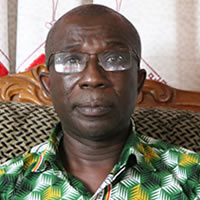District Economy
Structure of the Local Economy
The economy of Offinso Municipality can be analyzed under four broad categories namely Agriculture, Industry, Commerce and Services. Agriculture remains the dominant sector and employs more than 50 % of the labour force, as shown in table 8. This is followed by the service sector, which employs about 22% of the labour force. Commerce employs about 16%, whiles the about 10% of the labour force is employed in the industrial sector.
The local economy is dominated by small-scale activities, most of which have been in this state for a long period of time without growth. Medium and large scale industries are few, and they consist of electricity pole production, sawmills among others. The structure of the local economy is shown in the table below:
Marketing and Processing
Middle women mainly from Kumasi play an important role in the marketing of agricultural produce in the municipality. Most of the farmers sell their produce to the middle women and men on market days. They in turn sell them at urban markets within and outside the municipality.
However, these middle women dictate the prices of the agricultural produce. In most cases the prices are unfavourable to the farmers. Even though farmers complain about this situation, they have no alternative, since most of the items they produce are perishable.
Financial Institutions
There are four (4) commercial banks in the municipality. They are, Ghana Commercial Bank Ltd. located at Offinso New Town, Nwabiagya Rural Bank located at Offinso New Town, Offinso Rural Bank located at Offinso and Otuasekan Rural Bank located at Abofuor. There are other micro-financing companies operating in the Municipality. Notably among them are SINAPI ABA Trust and Multi-Credit. The Municipal Assembly should collaborate with these financial institutions to address the credit needs of local enterprises and to develop.
External Revenue
The main external revenue inflows to the Municipal Assembly are the District Assemblies’ Common Fund (DACF), the District Development Facility (DDF) and the Urban Development Grant (UDG). The estimated and actual amounts from these sources for 2010-2013 are as follows:
The Municipal Assembly projected to receive a total amount of GH¢4,719,072.13 from 2010 to 2013. The analysis of the DACF inflows indicated that actual allocation to the Municipal Assembly for the period was only 50 %. The analysis also indicated that about 50% of the actual amount allocated to the Municipal Assembly was deducted at source. A total of GH¢1,718,010.00 and GH¢544,644.82 was received from the District Development Facility (DDF) and Urban Development Grant (UDG) respectively from 2010 to 2013.
The shortfalls in the DACF and the huge deductions which were made at source affected implementation of planned projects and activities. This situation implies that the Municipal Assembly must put in place measures to continue to qualify for the DDF and UDG and to mobilize more internal revenue to finance its development activities. The Municipal Assembly must reduce its overdependence on the DACF.
Expenditure Structure
The structure of expenditure is made up of two (2) components namely: Recurrent and Capital (development). The recurrent is made up of the following item heads:
1. Personal Emoluments
2. Travelling and Transport
3. General Expenditure
4. Maintenance, repairs and Renewals
5. Miscellaneous
The capital or development expenditure on the other hand, is broken down into following headings:
1. Constructional works
2. Vehicles, Plants and Equipment
3. Other Capital Expenditure.
The budget structure for the year 2010-2013 is shown in table 18
Economic Resources of the Municipality
· Very good agriculture land for rice, vegetables, maize, cassava plantain, pawpaw, cocoa, citrus, ginger, yam,
cocoyam, guava, avocado oil palm, mangoes, coffee and livestock production
· High production of crops, cassava, plantain, maize, citrus, etc provides potentials for agro processing.
· Good quantity and quality of underground and surface water for potable water production, irrigation, etc
· Availability of festivals, historical sites and natural heritage for the development and promotion of international and domestic tourism
· Availability of stones for the building and road construction industry
· Availability of land for housing and industrial development for the Kumasi Metropolitan market
· Availability of good economic support infrastructure ( bitumen surfaced roads, electricity, communication facilities, etc)
· Availability of many private properties, periodic markets, etc for local revenue generation.
Employed and Unemployed
The economically active population (age 15-64) in 2013 was 43,180. Out of this, 22,949 were females whiles 20,231 were males. About 73.8% (31,867) of the economically active population in the municipality were employed. Most of those working were self-employed. A total of 1,727 people (representing about 4% of the population in the employable age, most of which are youth) were not employed. Real dependency ratio in the municipality is 153, meaning one productive worker supports more than one other dependent or non- worker.
There is the need for a comprehensive approach in tackling the unemployment challenge. More investment should be directed into income generation and job creation ventures using existing local resource potentials (in agriculture, sanitation, ICT, Agro-processing, natural resource restoration, repairs/ metal fabrication, etc) and other opportunities to reduce the unemployment situation and sustain any achievements made in the employment sector. The Municipal
Assembly must take advantage of the siting of a vehicle repairs/assembling industry at Offinso Old Town and the Transit Terminal at Sekamkrom in the municipality to provide sustainable jobs and incomes for the unemployed youth and women.
1.6.6 Key Economic Infrastructure in the Municipality
Date Created : 11/27/2017 2:50:56 AM






 facebook
facebook X (twitter)
X (twitter) Youtube
Youtube +233 593 831 280
+233 593 831 280 0800 430 430
0800 430 430 GPS: GE-231-4383
GPS: GE-231-4383 info@ghanadistricts.com
info@ghanadistricts.com Box GP1044, Accra, Ghana
Box GP1044, Accra, Ghana